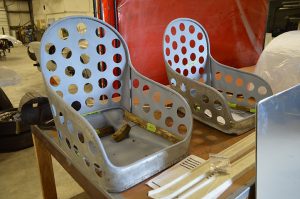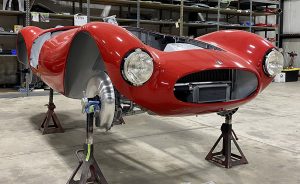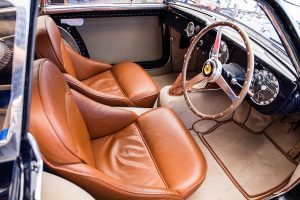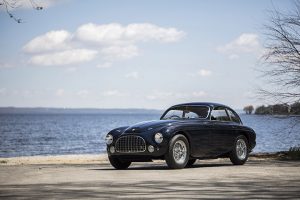The Factory Reset
Preserving the authenticity of a vintage automobile requires patience, precision, and extensive knowledge. Motion Products Inc. (MPI) specializes in Concours-level restoration – essentially taking a vehicle back to its original condition.
This type of work requires a team of experts – researchers, craftsmen, machinists, welders, painters and more. While MPI is known for their Pebble Beach-winning Ferrari restorations, their expertise extends beyond to other marques such as Maserati, Alfa Romeo, Porsche, and many others. The team at MPI works to restore vehicles to the days of their former glory, and they do this one piece at a time.
The goal at MPI is not only to make a vintage car look amazing, but to restore it to peak performance. This means solving a complex puzzle, reclaiming pieces and fitting them back together as originally built. At times when parts cannot be repaired or refurbished, they must be 3D printed on-site at MPI’s facility in Neenah, Wisconsin.
When MPI was founded in the 1980s, no such technology existed, just a passion for excellence. The founders, Wayne Obry and John Kies, were working in aviation, painting airplanes and upholstering machines for flight. However, Obry had always aspired to work on rare cars. He earned a chance in 1979 when he was asked to paint a Shelby Cobra and a Ferrari. Obry was so thrilled by the opportunity that he completed the job in his own garage. The founders committed to researching and learning the proper techniques used by original manufacturers in order to complete high- quality restoration projects.

Attention to detail reigns supreme as racing seats are taken down to bare metal and refurbished with a lightweight covering.
The staff at MPI have had the privilege of helping their clients cross the ramp at the Pebble Beach Concours d’Elegance over 60 times. MPI also had the honor of receiving the first-ever 100-point Ferrari at Pebble Beach with a 1953 Ferrari 212 Inter PininFarina Coupe #0263 EU in 1993. And co-founder Obry has worked his way to earn recognition as a lifetime International Advisory Council
for the Preservation of the Ferrari Automobiles judge and a vintage Ferrari consultant.
MPI has grown in many ways to adapt to the everyday changes and expectations of the industry. Their state-of-the-art shop is divided amongst three facilities, and MPI has partnered with some of the most well-known companies in the industry to increase capabilities.
On average, MPI will complete six or more full restorations a year, while also preserving more than 50 vehicles of all types.
INSIDE A RESTORATION
The restoration process is never a one-size-fits-all affair. At MPI, each client and each vehicle receive a tailored experience. What makes MPI different in the world of Ferrari auto restoration lies in their vertical integration.
“Whether a client wants to get a car back on the road, or get the car in a show, we have the expertise necessary to do that,” explained Kevin Caulfield, an advisor at MPI. “Not only can we do Concours-level restorations, we can handle event support and preparation, transportation to events, racing support, storage and maintenance. This is possible because we have over 75,000 square feet of restoration space with 50 talented artisans.”

After painting, the Maserati enters the assembly process. Original parts are then sourced for use or they are recreated in-house using machinists or 3D printing, if necessary.
A Concours-level restoration is never routine. Before beginning a project, MPI will talk with a client about intentions, needs and expectations to understand the full scope of a project. Once the project is firmly understood, the first step of the process begins: a vehicle examination.
“Research finds answers to questions such as who the first owner was, what color the car was originally and what kind of work has been performed on the vehicle,” Caulfield explained. “We then consult with owners as to objectives. Do they want the same appearance that the vehicle had in the Paris Auto Show of 1964? Or perhaps the way it looked when it left the factory in 1958. The goal is for our client to have a piece that is historically and accurately restored back to the day of its utmost glory.”
After research and scheduling, the car is disassembled, piece by piece. The assembly and disassembly team will keep track of every part that comes off the car to stay organized. Each part is sent to a specific department for restoration. The upholstery is sent to the upholstery department, the instruments are sent to the instrument department for cleaning and rebuilding, and the engine and gearbox are sent to the engine department for mechanical work. The only aspects of restoration not handled by MPI are windshield glass and plating – both of which are outsourced to local partners.
After disassembly, when only the chassis and the body remain, metalworking and trim fabrication come next. In this department the craftsmen shape metal, work with the chassis and interior sheet metal, measure and restore body panels, repair corrosion, and much more. The metalworking provides a solid foundation for a successful restoration.

The 1951 Ferrari 212 Export Berlinetta underwent a full restoration at MPI, right down to the leather upholstery and steering wheel.
“Cars were hand-built back then and are still repaired in the same fashion at MPI. Each one is slightly different due to parts of a vehicle being built for each specific car, making these some of the most unique cars in the world,” said Dave Jensen, MPI’s trim fabricator.
“Because we work with cars where only a handful were built or just a few are still in existence, we won’t find a fender or a door, they have to be fabricated,” Caulfied added. “Our artisans have the patience and the skill to shape the metal to perfectly match a specific vehicle.”
While the laborious task of metalworking is carried out, all other components of the car are being refurbished. The engine department will fully dismantle, assess, rebuild and reassemble the engine. After the engine is rebuilt, it is broken in utilizing a dynamometer. During a ‘dyno’ test, technicians study the overall performance of the engine, checking for leaks, and reviewing the overall dependability before it’s installed at the assembly stage.
Many of the cars that come to MPI for restoration often need little pieces restored too. All components are restored by hand or machined in-house. The components department takes care of ignitions, locks and latches, compressors, horns, brakes and more. Reproducing these pieces involves researching the appearance of the original piece, in some instances creating a mold.
“A client of ours requested we perform a 100-point restoration in preparation for the Ferrari Class at Pebble Beach. While disassembling the engine, it was discovered that a portion of the timing chain chest was held together with JB Weld. This posed a significant problem when we were unable to locate a replacement timing chest,” Caulfield explained. “We had to make a sympathetic repair, and we did so using 3D-printing technology. When completed, the repair was imperceptible, and that car went on to score 100 points at Pebble Beach and Best of Show at Cavallino. This demonstrates what our artisans are capable of.”
Because paint quality is often the first thing a person notices on a restored vehicle, MPI takes special pains to ensure an award-winning finish – a process that requires roughly one month. The bare aluminum or steel body is first thoroughly cleaned, then etching primer and epoxy are applied. The body is block sanded so every surface is perfectly smooth. A final primer is sprayed on the body and block sanded again before the final painting steps take place.

This 1951 Ferrari 212 Export Berlinetta Touring was also presented at the 2013 Cavalino Classic, where it scored Platinum. It is now displayed at the Ferrari museum in Modena, Italy.
After painting, the car is wheeled into the assembly room, where each vehicle has a dedicated row of shelves with freshly- restored components waiting to be reinstalled. “At this point, when all the components have been refinished and have been pieced back together,” Caulfield elaborated, “the vehicle should look no different than when it left the factory. Every piece and component will match, down to the fasteners that secure the battery.”
When all is said and done, 98% of the restoration process is completed on-site at MPI, allowing the car owner to see their asset from bare metal disassembly to the show field at Cavallino, typically within the span of a year.
“More importantly, our restorations stand the test of time,” Caulfield said. “In January of 2020, we had a client’s car win best of show at Cavallino. This particular Ferrari MPI restored over eight years ago. Ultimately, there is only one right way to restore automobiles of this caliber. Fortunately, our clientele can appreciate the pains we take to restore these rare machines.”
Related Stories
Cheers to 20 Years
Six members of Team Jet Linx celebrate two decades of Five-Star service.
READ MORE
Immerse Yourself
More than 40 years after pioneering one of the first health and wellness resorts in Tucson, AZ, Jet Linx Elevated Lifestyle partner Canyon Ranch continues to redefine what wellness-focused getaways can offer.
READ MORE
What Kind of Caviar Are You?
Whether you are a caviar newbie or a seasoned connoisseur, Jet Linx Elevated Lifestyle partner Petrossian has a caviar for your tastes.
READ MORE
Related Stories
Cheers to 20 Years
Six members of Team Jet Linx celebrate two decades of Five-Star service.
READ MORE
Immerse Yourself
More than 40 years after pioneering one of the first health and wellness resorts in Tucson, AZ, Jet Linx Elevated Lifestyle partner Canyon Ranch continues to redefine what wellness-focused getaways can offer.
READ MORE
What Kind of Caviar Are You?
Whether you are a caviar newbie or a seasoned connoisseur, Jet Linx Elevated Lifestyle partner Petrossian has a caviar for your tastes.
READ MORE



Contact Us